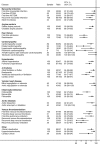Positive predictive value of cardiovascular diagnoses in the Danish National Patient Registry: a validation study - PubMed (original) (raw)
Positive predictive value of cardiovascular diagnoses in the Danish National Patient Registry: a validation study
Jens Sundbøll et al. BMJ Open. 2016.
Abstract
Objective: The majority of cardiovascular diagnoses in the Danish National Patient Registry (DNPR) remain to be validated despite extensive use in epidemiological research. We therefore examined the positive predictive value (PPV) of cardiovascular diagnoses in the DNPR.
Design: Population-based validation study.
Setting: 1 university hospital and 2 regional hospitals in the Central Denmark Region, 2010-2012.
Participants: For each cardiovascular diagnosis, up to 100 patients from participating hospitals were randomly sampled during the study period using the DNPR.
Main outcome measure: Using medical record review as the reference standard, we examined the PPV for cardiovascular diagnoses in the DNPR, coded according to the International Classification of Diseases, 10th Revision.
Results: A total of 2153 medical records (97% of the total sample) were available for review. The PPVs ranged from 64% to 100%, with a mean PPV of 88%. The PPVs were ≥90% for first-time myocardial infarction, stent thrombosis, stable angina pectoris, hypertrophic cardiomyopathy, arrhythmogenic right ventricular cardiomyopathy, takotsubo cardiomyopathy, arterial hypertension, atrial fibrillation or flutter, cardiac arrest, mitral valve regurgitation or stenosis, aortic valve regurgitation or stenosis, pericarditis, hypercholesterolaemia, aortic dissection, aortic aneurysm/dilation and arterial claudication. The PPVs were between 80% and 90% for recurrent myocardial infarction, first-time unstable angina pectoris, pulmonary hypertension, bradycardia, ventricular tachycardia/fibrillation, endocarditis, cardiac tumours, first-time venous thromboembolism and between 70% and 80% for first-time and recurrent admission due to heart failure, first-time dilated cardiomyopathy, restrictive cardiomyopathy and recurrent venous thromboembolism. The PPV for first-time myocarditis was 64%. The PPVs were consistent within age, sex, calendar year and hospital categories.
Conclusions: The validity of cardiovascular diagnoses in the DNPR is overall high and sufficient for use in research since 2010.
Keywords: CARDIOLOGY; EPIDEMIOLOGY.
Published by the BMJ Publishing Group Limited. For permission to use (where not already granted under a licence) please go to http://www.bmj.com/company/products-services/rights-and-licensing/.
Conflict of interest statement
Conflicts of Interest: None declared.
Figures
Figure 1
Positive predictive values of cardiovascular diagnoses in the Danish National Patient Registry. Ratio, denotes confirmed diagnoses/available records; PPV, positive predictive value; STEMI, ST segment elevation myocardial infarction; NSTEMI, non-STEMI.
Similar articles
- Positive predictive value of cardiac examination, procedure and surgery codes in the Danish National Patient Registry: a population-based validation study.
Adelborg K, Sundbøll J, Munch T, Frøslev T, Sørensen HT, Bøtker HE, Schmidt M. Adelborg K, et al. BMJ Open. 2016 Dec 9;6(12):e012817. doi: 10.1136/bmjopen-2016-012817. BMJ Open. 2016. PMID: 27940630 Free PMC article. - Positive predictive value of International Classification of Diseases, 10th revision, diagnosis codes for cardiogenic, hypovolemic, and septic shock in the Danish National Patient Registry.
Lauridsen MD, Gammelager H, Schmidt M, Nielsen H, Christiansen CF. Lauridsen MD, et al. BMC Med Res Methodol. 2015 Mar 20;15:23. doi: 10.1186/s12874-015-0013-2. BMC Med Res Methodol. 2015. PMID: 25888061 Free PMC article. - Accuracy of angina pectoris and acute coronary syndrome in the Danish National Patient Register.
Bork CS, Al-Zuhairi KS, Hansen SM, Delekta J, Joensen AM. Bork CS, et al. Dan Med J. 2017 May;64(5):A5369. Dan Med J. 2017. PMID: 28552092 - Neurological and psychiatric comorbidity in patients with heart failure: risk and prognosis.
Adelborg K. Adelborg K. Dan Med J. 2018 Apr;65(4):B5429. Dan Med J. 2018. PMID: 29619930 Review. - Mortality and morbidity in patients with osteogenesis imperfecta in Denmark.
Folkestad L. Folkestad L. Dan Med J. 2018 Apr;65(4):B5454. Dan Med J. 2018. PMID: 29619932 Review.
Cited by
- SGLT-2 inhibitors and mortality among patients with heart failure with reduced ejection fraction: linked database study.
Svanström H, Mkoma GF, Hviid A, Pasternak B. Svanström H, et al. BMJ. 2024 Nov 6;387:e080925. doi: 10.1136/bmj-2024-080925. BMJ. 2024. PMID: 39505389 Free PMC article. - Validity of a Hypertrophic Cardiomyopathy Diagnosis in Adult Patients in the Danish National Patient Register.
Severinsen T, Gudmundsdottir HL, Axelsson Raja A, Fosbøl EL, Bundgaard H, Thune JJ. Severinsen T, et al. Clin Epidemiol. 2024 Oct 22;16:743-751. doi: 10.2147/CLEP.S467341. eCollection 2024. Clin Epidemiol. 2024. PMID: 39464788 Free PMC article. - Incidence of Recurrent Venous Thromboembolism in a Population-Based Cohort.
Ruthström T, Hägg L, Johansson L, Lind MM, Johansson M. Ruthström T, et al. Clin Appl Thromb Hemost. 2024 Jan-Dec;30:10760296241293337. doi: 10.1177/10760296241293337. Clin Appl Thromb Hemost. 2024. PMID: 39449367 Free PMC article. - Empagliflozin Use Is Associated With Lower Risk of All-Cause Mortality, Hospitalization for Heart Failure, and End-Stage Renal Disease Compared to DPP-4i in Nordic Type 2 Diabetes Patients: Results From the EMPRISE (Empagliflozin Comparative Effectiveness and Safety) Study.
Langslet G, Nyström T, Vistisen D, Carstensen B, Grip ET, Casajust P, Tskhvarashvili G, Hoti F, Klement R, Karlsdotter K, Tuovinen M, Ofstad AP, Lajer M, Shay C, Koeneman L, Farsani SF, Niskanen L, Halvorsen S. Langslet G, et al. J Diabetes Res. 2024 Oct 12;2024:6142211. doi: 10.1155/2024/6142211. eCollection 2024. J Diabetes Res. 2024. PMID: 39430801 Free PMC article. - Temporal changes in characteristics, incidence, and mortality in patients undergoing surgical intervention for mitral stenosis.
Due HT, Petersen JK, Meulengracht DE, Smerup MH, Schmidt MR, Køber L, Fosbøl E, Østergaard L. Due HT, et al. Sci Rep. 2024 Oct 16;14(1):24288. doi: 10.1038/s41598-024-74807-5. Sci Rep. 2024. PMID: 39414856 Free PMC article.
References
- Schmidt M, Jacobsen JB, Lash TL et al. . 25 year trends in first time hospitalisation for acute myocardial infarction, subsequent short and long term mortality, and the prognostic impact of sex and comorbidity: a Danish nationwide cohort study. BMJ 2012;344:e356 10.1136/bmj.e356 - DOI - PMC - PubMed
Publication types
MeSH terms
LinkOut - more resources
Full Text Sources
Other Literature Sources
